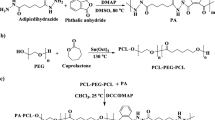Abstract
Sulfonamide-containing linear copolymers were synthesized via copolymerization of N-(4-methacrylamido)-N′-(4,6-dimethylpyrimidin-2-yl) benzene-1-sulfonamide (SAM) and N,N′-dimethylacrylamide (DMAAm) via free-radical polymerization at room temperature using redox initiators. The redox-initiated polymerization could undergo nearly complete reaction in which the copolymer composition was almost the same as the feeding monomer ratio. These linear copolymers could be dissolved in water and displayed pH-sensitive properties around the physiological pH value of human body with a very sharp transition window less than 0.1 pH unit. Moreover, by introducing N-methyloyl acrylamide (NMA) monomer into the reaction system, the resulting copolymers could become crosslinked hydrogels when subjected to post thermo-curing through the NMA units. The crosslinking density and pH-sensitivity could be manipulated by changing the curing time and temperature. Therefore, swelling ratio and gel fraction of hydrogels could be accurately tailored. The pH-sensitive windows of these hydrogels were found to maintain in between 6.80 to 7.40, which implied that these hydrogels would be a suitable candidate for biomedical materials.






Similar content being viewed by others
References
Qiu Y, Park K (2001) Environment-sensitive hydrogels for drug delivery. Adv Drug Deliv Rev 53(3):321–339. https://doi.org/10.1016/S0169-409X(01)00203-4
Hennink WE, van Nostrum CF (2012) Novel crosslinking methods to design hydrogels. Adv Drug Deliv Rev 64:223–236. https://doi.org/10.1016/j.addr.2012.09.009
Lee KY, Mooney DJ (2001) Hydrogels for Tissue Engineering. Chem Rev 101(7):1869–1880. https://doi.org/10.1021/cr000108x
Babaladimath G, Badalamoole V (2018) Pectin-graft-poly(2-acrylamido-2-methyl-1- propane sulfonic acid) silver nanocomposite hydrogel beads: evaluation as matrix material for sustained release formulations of ketoprofen and antibacterial assay. J Polym Res 25(9):202
Peppas NA, Bures P, Leobandung W, Ichikawa H (2000) Hydrogels in pharmaceutical formulations. Eur J Pharm Biopharm 50(1):27–46. https://doi.org/10.1016/S0939-6411(00)00090-4
Kabanov AV, Vinogradov SV (2009) Nanogels as pharmaceutical carriers: finite networks of infinite capabilities. Angew Chem Int Ed 48(30):5418–5429. https://doi.org/10.1002/anie.200900441
Satarkar NS, Hilt JZ (2008) Magnetic hydrogel nanocomposites for remote controlled pulsatile drug release. J Control Release 130(3):246–251
Ma L, Liu M, Liu H, Chen J, Cui D (2010) In vitro cytotoxicity and drug release properties of pH- and temperature-sensitive core-shell hydrogel microspheres. Int J Pharm 385(1–2):86–91. https://doi.org/10.1016/j.ijpharm.2009.10.037
Lin C-L, Chiu W-Y, Lee C-F (2006) Preparation, morphology, and thermoresponsive properties of poly(N-isopropylacrylamide)-based copolymer microgels. J Polym Sci Part A: Polym Chem 44(1):356–370. https://doi.org/10.1002/pola.21134
Traitel T, Cohen Y, Kost J (2000) Characterization of glucose-sensitive insulin release systems in simulated in vivo conditions. Biomaterials 21(16):1679–1687
Liu Y, Meng L, Lu X, Zhang L, He Y (2008) Thermo and pH sensitive fluorescent polymer sensor for metal cations in aqueous solution. Polym Adv Technol 19:137–143
Zrínyi M (2000) Intelligent polymer gels controlled by magnetic fields. Colloid Polym Sci 278(2):98–103
Gil ES, Hudson SM (2004) Stimuli-responsive polymers and their bioconjugates. Prog Polym Sci 29(12):1173–1222
Zha L, Banik B, Alexis F (2011) Stimulus responsive nanogels for drug delivery. Soft Matter 7(13):5908. https://doi.org/10.1039/c0sm01307b
Che Y, Li D, Liu Y, Yue Z, Zhao J, Ma Q, Zhang Q, Tan Y, Yue Q, Meng F (2018) Design and fabrication of a triple-responsive chitosan-based hydrogel with excellent mechanical properties for controlled drug delivery. J Polym Res 25(8):169
Khan A, Sajjad M, Khan E, Md. Akil H, Shah LA, Farooqi ZH (2017) Synthesis, characterization and physiochemical investigation of chitosan-based multi-responsive Copolymeric hydrogels. J Polym Res 24(10):170
Lee AS, Bütün V, Vamvakaki M, Armes SP, Pople JA, Gast AP (2002) Structure of pH-dependent block copolymer micelles: charge and ionic strength dependence. Macromolecules 35(22):8540–8551
Weaver JVM, Bannister I, Robinson KL, Bories-Azeau X, Armes SP, Smallridge M, McKenna P (2004) Stimulus-responsive water-soluble polymers based on 2-hydroxyethyl methacrylate. macromolecules 37(7):2395–2403. https://doi.org/10.1021/ma0356358
Gan LH, Roshan Deen G, Gan YY, Tam KC (2001) Water sorption studies of new pH-responsive N-acryloyl-N′-methyl piperazine and methyl methacrylate hydrogels. Eur Polym J 37(7):1473–1478. https://doi.org/10.1016/S0014-3057(00)00250-0
Yin X, Stöver HDH (2003) Hydrogel microspheres formed by complex coacervation of partially MPEG-grafted poly(styrene-alt-maleic anhydride) with PDADMAC and cross-linking with polyamines. Macromolecules 36(23):8773–8779. https://doi.org/10.1021/ma034617n
Kurdtabar M, Koutenaee RN, Bardajee GR (2018) Synthesis and characterization of a novel pH-responsive nanocomposite hydrogel based on chitosan for targeted drug release. J Polym Res 25(5):119
Ghamkhari A, Agbolaghi S, Poorgholy N, Massoumi B (2018) pH-responsive magnetic nanocomposites based on poly(2-succinyloxyethyl methacrylate-co-methylmethacrylate) for anticancer doxorubicin delivery applications. J Polym Res 25(2):37
Wike-Hooley JL, Haveman J, Reinhold HS (1984) The relevance of tumour pH to the treatment of malignant disease. Radiother Oncol 2(4):343–366. https://doi.org/10.1016/S0167-8140(84)80077-8
Lardner A (2001) The effects of extracellular pH on immune function. J Leukoc Biol 69(4):522–530
Kang SI, Bae YH (2002) pH-induced solubility transition of sulfonamide-based polymers. J Control Release 80(1–3):145–155. https://doi.org/10.1016/S0168-3659(02)00021-4
Park SY, Bae YH (1999) Novel pH-sensitive polymers containing sulfonamide groups. Macromol Rapid Commun 20(5):269–273
Bae YH, Park SY (2000) pH-sensitive polymer containing sulfonamide and its synthesis method. US patent 6:103,865
Kang SI, Na K, Bae YH (2001) Sulfonamide-containing polymers: a new class of pH-sensitive polymers and gels. Macromol Symp 172:149–156
Na K, Bae YH (2002) Self-assembled hydrogel nanoparticles responsive to tumor extracellular pH from pullulan derivative/sulfonamide conjugate: characterization, aggregation, and adriamycin release in vitro. Pharm Res 19(5):681–688
Shim WS, Kim J-H, Park H, Kim K, Chan Kwon I, Lee DS (2006) Biodegradability and biocompatibility of a pH- and thermo-sensitive hydrogel formed from a sulfonamide-modified poly(ε-caprolactone-co-lactide)–poly(ethylene glycol)–poly(ε-caprolactone-co-lactide) block copolymer. Biomaterials 27(30):5178–5185. https://doi.org/10.1016/j.biomaterials.2006.05.038
Sarac AS (1999) Redox polymerization. Prog Polym Sci 24(8):1149–1204. https://doi.org/10.1016/S0079-6700(99)00026-X
Author information
Authors and Affiliations
Corresponding authors
Rights and permissions
About this article
Cite this article
Kuo, CY., Don, TM., Lin, YT. et al. Synthesis of pH-sensitive sulfonamide-based hydrogels with controllable crosslinking density by post thermo-curing. J Polym Res 26, 18 (2019). https://doi.org/10.1007/s10965-018-1672-6
Received:
Accepted:
Published:
DOI: https://doi.org/10.1007/s10965-018-1672-6




